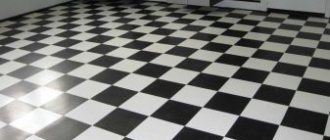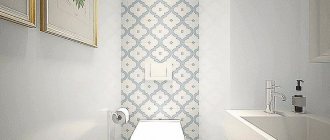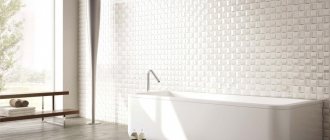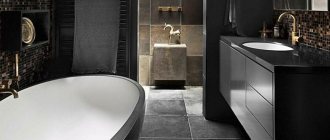The final stage of laying tiles is jointing or grouting. With the help of properly executed grout, you can easily mask small defects that probably arose during installation. But how to choose a grout for tiles in order to highlight the beauty of the tiles and not spoil the overall appearance of the surface and the room itself? The hygiene and tightness of the surface depends on the correct choice of fugue, both its color and properties and, of course, high-quality filling of the seams. If you do not use grout, dust and debris will get into the cracks between the tiles, and over time, small insects may even settle there. In addition, if you do not seal the seams, moisture will quickly get under the tiles, and this increases the likelihood of fungus.
Main types of tile grout
When choosing grout for tiles, you need to be guided by its type and purpose. High-quality tile grouts usually contain cement, varnishes, latex and impregnations. Before choosing a specific type, you should familiarize yourself with the characteristics of the material and, based on this, choose the optimal one for your case.
Today, manufacturers offer two types of tile grout - epoxy resin-based and cement-based. To fill difficult places in the cladding, there are silicone sealants specially designed for this purpose. Remember that you can start only after 24 hours after laying the tiles.
Cement-based grouts are usually dry mixtures that are diluted with water or liquid latex before use. Ready-made grouts are also sold, which do not need to be diluted, but their cost is significantly higher. Cement grouts can be with or without the addition of sand. Grouting with the addition of sand is recommended for use in cases where the width of the joints between the tiles is more than 3 mm. If the width of the joints is less than 3 mm, then cement grout without sand is more suitable. You can always read in the manufacturer's instructions what width of seams this fugue is intended for.
Some grades of these two types of grout can be used on both enameled and non-enameled tiles. But it is worth considering that sanded grout should not be used on surfaces that can be easily scratched, for example, sensitive glazed tiles or marble.
It is worth noting that cement grouts have their drawbacks: they are usually not resistant to moisture and cleaning agents. In addition, the color range of such grouts is very poor, because the color is dictated by the materials. Therefore, most often cement grout is gray or white.
Epoxy grouts contain epoxy resin and a hardener. They make the seams more resistant to mechanical damage and various chemical influences. Epoxy grout can retain its original color for up to 50 years. Since this grout is quite expensive, it is rarely used at home. Usually only specialists work with it, since this fugue is very viscous and you need to have the skills to work with it. Epoxy grout is used in cases where the joint width is more than 6 mm. If the width of the tile joints is smaller, then it makes no sense to use this fugue, since it simply will not penetrate such narrow joints.
You can also find grout with latex in stores. But they need to be coated with a special moisture-resistant grout varnish. This way the grout will retain its color longer and will practically not absorb moisture.
How to choose grout for beige tiles?
Beige color is universal, and a kitchen or bathroom decorated with tiles of this shade is not only gentle and beautiful, but also practical. In order not to overdo it with the color scheme, the grout must be selected taking into account some factors, such as: the color and style of furniture, interior items and household items. The composition of the grout is chosen taking into account the conditions in which the tile will be located.
Selecting grout color
Choosing a grout color is a very important and responsible stage, since an incorrectly chosen shade can ruin your entire “picture” and, on the contrary, with the help of a well-chosen color you can very well transform the tiled surface, advantageously emphasize the advantages of the chosen tile and hide minor flaws made in the process of laying tiles.
Of course, in such a matter as choosing the color of grout for tiles, an individual approach is needed, which depends on the color of the tile itself, as well as the color of other elements of the room. The classic version is most often used, when the darkest shade of the tile color is selected and a fugue of exactly that color is purchased, but not darker. In the same way, in some cases, it is more advisable, on the contrary, to choose the lightest tone in the color of the tile and use such grout. It all depends on the specific case.
When choosing a grout color, it is important to remember a simple rule: if you choose a grout that is lighter than the tile, then visually all the tiles will merge, and if you choose a grout that is darker than the tile itself, then each tile will stand out, which will create a catchy geometric pattern of the entire composition. Playing with contrast goes well with small-sized tiles, as well as mosaics. If you have photo tiles or a mosaic panel, then it is better to match the color with the cladding or choose a transparent colorless fugue.
If you decide to choose an overly contrasting grout, be sure to first check it on a separate copy to see if it will stain the tile. In any case, you need to wait until the grout dries, as it changes color. If you see that stains remain on the tiles, then you should choose a different grout or use a special liquid filler designed to cover the tiles immediately before jointing.
If you are lost among the many shades and cannot choose the right color, then feel free to choose a white fugue. This is the most win-win option. White grout is almost perfect for most tiles. Remember that in wet rooms it must be moisture resistant. To prevent darkening, the seams can be additionally treated with a special protective agent. But for floors, white color is completely unsuitable, since very soon such grout will look dirty. Here it is worth using gray grout, similar in color to cement. Brown or blue-gray grout is also perfect for the floor.
Jointing, as well as laying tiles itself, is a rather painstaking process that requires attention and accuracy. To obtain reliable protection of surfaces from dirt and moisture, you should choose only good quality grout. And be sure to make sure that it matches harmoniously in color. It is in this case that you will get an excellent result, and your walls and floors will look beautiful and neat.
(it is also called “fugue”) - a mixture based on polymers or cement, which protects joints and seams from moisture, mold, debris, dust, helps smooth out certain finishing defects, and gives integrity to the entire surface. Without grouting, the appearance of the walls on which the tiles were laid is unlikely to satisfy demanding owners - the adhesive mortar and cement between the tiles looks unattractive. Grouting allows you to give the decor real aesthetics and expressiveness.
Selecting the color of grout for bathroom tiles is an important task; the wrong decision here can ruin the finish. MiracleVanna will tell you how to choose the color of grout for tiles.
| Contents of the article: 1. 2. 3. 4. 5. 6. |
Grout color palette
Different manufacturers have different color palettes. In basic colors like white, several grays and black, they overlap, but in others they differ significantly.
By the way, we are in:
Grout Ceresit colors
The most commonly used grout in the CIS countries is ceresit. They have several types of grout CE 33, CE 40 and CE 25. The most commonly used grout is Ceresit CE 40 and it has the widest range of colors. Ceresite CE 40 holds moisture and minor deformations well, which means it is less likely to crack due to minor shrinkage and vibrations. Quite a good choice, but there are some nuances in the colors.
Everything is clear with neutral colors; you can get an idea about them by looking at the sticker on the jar or bag. But with more complex flowers, for example Jasmine, Crocus, Sahara and some others, strange things happen. The actual color after grouting and drying is not at all similar to what is indicated on the can.
Perhaps they are fundamentally different, perhaps the printing house conveys it poorly, but the fact remains: the choice of Ceresit grout color must be made after a trial application and drying. Yes, this complicates the process somewhat, but it is better to first buy a minimum amount, apply and let it dry, and then buy everything else. How to immediately wipe all the seams, and in fact remain dissatisfied with the resulting color.
Litokol grout colors
The Litokol brand has perhaps the widest range of grout types and color palette. We will mention their epoxy options later, because... they are not very popular due to their high price. But their line of regular grouts deserves attention.
Their Litochrom line includes, among other things, grout in our favorite gray colors in the amount of 4 pieces. We used all 4 in one apartment for different surfaces. There were no problems with them. What is important is that the color of the sticker on the packaging very closely reflects the final color of the seams after drying. Although Ceresit had no problems with the grays either.
Litokol C.10 gray and C.30 pearl gray can be used as basic universal grout colors.
Grout Satin colors
Another popular grout brand. It is used widely and the reviews are generally good. We have no experience working with it, so we’ll just give you a palette of Atlas grout colors.
Kiilto grout colors
Unfortunately, I also have no experience of using it, but I don’t want to invent it. But the Kiilto color palette is quite wide, we’ll just give it here. If you have experience using this or any other grout, please share it in the comments.
Two-component grout
It's very expensive. This type of epoxy grout is not particularly popular due to its price. In addition to the price, it is difficult to apply, difficult to remove excess residue and wash. If you have a decent budget and your builders have experience working with epoxy grouts, then they should be your choice. They are much more resistant to dirt and are not afraid of moisture at all.
And most importantly, epoxy grouts have a huge number of colors. Including all sorts of glosses, sparkles and even options that glow in the dark. The Litokol brand has a wide range of epoxy grouts. But all this is beyond the scope of this article.
Conclusions on what color of grout to use:
- The color of the tiles is darker for the floor and lighter for the walls.
- If you can’t find it in color, then use gray that matches in tone.
- White only for white tiles, only on the walls and not in the kitchen.
Save and share - it will come in handy!
How to choose tile grout by color? Traditional options
First of all, those who are engaged in such a selection should pay attention to the traditional palette of grouts, consisting of the most popular colors:
- white;
- red;
- blue;
- green;
- blue;
- orange;
- black;
- violet.
This palette can be called standard. Of course, some large grout manufacturers can offer much more expanded palettes, which can contain several dozen shades.
The traditional option is when the grout is chosen to be the same color as the tile or a close, similar color. That is, for example, for dark brown tiles, it is important to use chocolate or beige grout.
Another classic, win-win solution is to choose white grout. It more or less matches any tile color. But this doesn't apply to gender. Here the white grout will quickly lose its presentation and take on a dirty gray tint.
The white color will highlight each individual tile and outline its boundaries. If the tile itself is white, then the end result will be a kind of monolithic space, which is also quite pleasant to contemplate.
Also, white grout is the best choice when tiles of several different colors are used in the design of the bathroom, and which one to focus on remains unclear.
Interior use
Such a bold and contrasting combination is suitable only for modern styles, for example, urban, loft, modern and even Scandinavian. In all these design areas, it is necessary to adhere to the principles of minimalism.
This also applies to the choice of ceramic tiles. That is, it should be plain or (maximum) with a natural pattern like wood or stone. If there is an active ornament on the tile, then in combination with contrasting seams the interior will be overloaded.
How to choose a tile grout color to create contrast?
Another, more complex (requiring a certain taste and aesthetic sense) option is playing with contrast. If you have a penchant for experimentation and bright solutions, you should try combining several dissimilar tones in the interior. Moreover, today contrasts in the interior are at the height of fashion.
For example, the Itten circle, in which contrasting pairs of colors are presented as clearly as possible, will help you choose the right combination of tile and grout colors. It is these pairs that you should focus on when choosing a color.
There is another intuitive rule: light colors contrast with dark ones. Here are some specific examples: the contrast color for red will be green, for orange - blue, for yellow - lilac, for light green - pink, for gray - purple. Here, however, it is worth remembering that a light fugue, as it were, collects the entire wall canvas together, and a dark fugue breaks it into small pieces and fragments. In addition, our vision is designed in such a way that light elements always seem to be pushed forward compared to dark ones, even if they are on the same line. And the dark elements seem to be located a little further, in the depths.
Experienced designers know that sometimes seemingly incompatible tones can give a good result. On the other hand, a fugue of a color that a person considered to be in contrast to the tiles may end up looking awkward and ridiculous.
By the way, a contrasting option will be especially appropriate if the tile has a rather non-standard shape or a very bright color that you want to highlight.
What is glitter grout?
This grout is a mixture of ordinary mortar, which is used to grout the tile joint.
They are mixed in exactly the same way as regular floor grout, however, when dry they give an interesting visual effect. There are these types of grout:
- with small elements - the seam shimmers a little;
- with large elements - when hit by light, the particles shine noticeably;
- luminescent - glow faintly in semi-darkness or darkness.
Assortment of shiny grouts
The idea of creating a shiny tile grout is appropriate not only in clubs and other establishments where the emphasis is on the interior, but also in private homes. For example, silver-gray grout will perfectly emphasize the cold tone of the tiles and give the room a stylish note. But classic gold grout will be more appropriate in warm design options, where the tiles are predominantly beige, brown and other warm tones.
Grout for white tiles
Some of the most popular tile colors chosen for bathtubs and bathrooms are still white and black. Bathrooms in this style can be seen both in residential apartments and in public spaces (for example, in clubs, theaters, cafes, restaurants, etc.).
If white tiles were chosen, there are a lot of possible grout colors. As already mentioned, white goes well with almost any other color. And an absolutely stunning contrast can be achieved if you match the white tiles with black grout. But at the same time, the tiles must be laid perfectly, otherwise even the smallest flaws in the cladding will be very noticeable.
Here you can not pay attention to the tiles at all, and choose grout to match the accessories. If, for example, the curtain in the bathroom, towels, and soap dishes are orange, then this is the color you should choose for the grout.
What grout color to choose for beige tiles
Hello my dear girls! I need your help. We were choosing tiles and finally chose. My pregnant brain chose beige colors, although I love bright ones(((What to do. Please rate. Help. How to decorate all this beautifully? What color should I add accessories? And what color of grout would be suitable. I attach a photo of the project. The collection cannot be changed (everything is paid for) Tile collection: Meisha / Garam (“Paradyz”, Poland) Continue reading →
Kitchen color: beige Countertop color: wood Tile color: beige hog Grout color: ? Which grout to choose, help? What is needed to be good? I like it in the photo, but I don’t really understand what shade was used... I only see that it’s not white! (Photo from the Internet) Read more →
I'm looking for advice. Our kitchen has been under renovation for a very long time. Hope loomed on the horizon to finish it soon. The idea is simple - I want to make a “cafe” style kitchen. There is a general idea of how everything will be. And there is a condition from the husband, “not to make grandma’s den.” Well, it’s standard: “there’s no money for anything” :) How to beat everything so that “both the wolves are fed and the sheep are safe” has left me scratching my head. Plus, I'm not really sure how to combine everything. And most importantly, about the wallpaper. It was there for a long time. Continue reading →
The tiles chosen for the bathroom are beige + brown + decor with gold, all the plumbing will be white. What color do you think should be used to grout the seams: 1. Or is it beige, where the tiles are beige and the grout on the brown tiles is dark in color.2. wipe all seams with white3. rub all seams in beige Read more →
Budget arrangement of the “Khrushchev” kitchen without redevelopment (my ideas, tips and mistakes) Source https://ideas.vdolevke.ru/posts/16023/biudzhetnoe-obustroystvo-hrushyovskoy-kuhni/ Read more →
Girls, please advise which color to choose for Litokol epoxy grout. We will be grouting light beige floor tiles in the kitchen. Continue reading →
Girls, hello! We have started renovating the bathroom and toilet. Now we have a question about the toilet. We chose this tile, only in the red version on the bottom (I couldn’t find a photo) Read more →
Which tiles to choose for the backsplash? There are several selection criteria. Firstly, practicality. After all, there are always greasy splashes in the stove area, and fish scales in the sink area. You need to choose a tile that is easy to clean, and if you don’t have the strength to wash it in time, then at least it won’t be noticeable! After all, we are all mothers, we get tired and don’t have time. Of course not white or blue. The yellow fat will be very noticeable on these flowers. And immediately refuse white grout! Conclusion: Yellow, beige, brown, green, olive, gray are perfect. Continue reading →
Grout for black tiles
For black tiles, approximately the same rules apply as for white ones. This is explained by the fact that both colors are achromatic, which means they can be combined with all others without problems. Black tiles look great in combination with pearlescent, red and yellow grout.
You can choose black grout to match this tile. But here you have to be careful. It is noted that this solution is not suitable for small rooms. As a result, it will look even smaller - it will be uncomfortable here. And there are also cases when black grout in practice looks dark gray, which does not give the result that the buyer expected. That is, black grout must be really black.
Tips for choosing
The putty should be purchased at the same time as the tiles, so that there is no doubt about whether the building materials will fit together. When choosing a color, you can completely rely on your taste and preferences, because there are no strict restrictions in this regard.
The grout should favorably emphasize the quality of the tile used. If difficulties arise during a purchase, you can always count on the help of sales consultants in a specialized store.
It is recommended to buy tiles and grout together
Light tiles with dark grout allow you to focus attention on the tiles. It looks very unusual. This solution is widely used by supporters of the “industrial genre”. But it is worth noting that in this case the walls become rougher in appearance.
To choose the right combination, you should pay attention to the floor in the bathroom. The darker it is, the richer the grout paste should be in the space between the tiles. Otherwise, the color of the room’s floor will be striking against the background of pale walls.
Light tiles with dark grout allow you to focus attention on the tiles
By choosing a blue putty, you can achieve the effect of smoothing out existing unevenness on the surface. In this case, it would not be amiss to add a lamp with a soft glow. Such tones, combined with moderate lighting, will create a pleasant atmosphere in the room.
This option can create coziness and comfort in the room.
Color palettes from famous tile grout manufacturers
The palettes available in every hardware store will help you choose the color of grout for the tiles. You can approach such a palette with a selected tile sample and, applying it to a particular color, evaluate their compatibility.
Grout color palette for Ceresit tiles
Atlas grout color palette
Ultracolor plus grout colors (Mapei)
Litokol grout colors
Unis grout colors
A good tip for potential fugue buyers is to go to the store with a sample of the tile. And then at home, grout not the entire surface area, but only a small area that is located in an inconspicuous place. The fact is that grout can be sold both in dry form and in the form of a ready-made solution. And after drying, it may change its shade slightly.
Note that when choosing in a store, you should think about other parameters besides color - manufacturer, type, cost, etc. Consultation with a sales consultant will not be superfluous here.
Of course, over time, even very high-quality grout can lose its original appearance. But here special joint paints can come to the rescue. In the end, you can go over the tiled surface and apply completely new grout - this will significantly refresh the interior. That is, grouting can be an inexpensive way to introduce something new into an environment that has not changed for a long time.
There is probably not a single room where tiled building material would not be laid. The assortment of it in any hardware store is very large and varied. This leads to the fact that the buyer cannot make a choice. When the choice is made, the polite sales consultant immediately asks the question: “What kind of tile grout should we use?” And again, many questions arise: “How to decide on the color of the grout for the cladding so that it complements the overall background and harmonizes with it?”
Today, the article will provide answers to this and many other questions that relate to the topic of how to choose grout for tiles.
Main functions of grout
Once you have already decided on the tile, you need to choose the right grout color. It is designed to perform the following functions:
- protect building materials from moisture penetration;
- eliminate temperature gaps;
- decorate the surface.
The main task of the grout is to protect against moisture getting under the tiles.
Due to the fact that high humidity prevails in the bathroom, it is worth focusing on protecting the tiles from premature destruction. The putty is applied to the tile joints to ensure the tightness of the building material.
If there is high moisture in the room, it is worth caulking the seams to prevent premature destruction of the material.
Grouts for building materials: types and photos
The main purpose of grout
for cladding
is to fill joints to protect the edges of the tiles from moisture and temperature changes. In addition, the grout must perform a decorative function, which can be seen in the photo.
Types of grout used today
- Based on epoxy resins
. This method contains a coloring element and substances that ensure the density and hardness of the seam. This composition can be used in rooms with direct sun, it does not fade, stains do not appear on it, and is very elastinous when laying; - Cement
. This grout is based on various additives that help give the mixture the necessary qualities: uniform distribution along the seam, ease of use, homogeneous mass, quick drying. This type of mixture is suitable for seams no larger than 05 cm. In the store you buy this mixture in the form of a powder, which must be diluted with water until it becomes thick sour cream. If the seams in the tiles exceed 0.5 cm, then a cement mixture with the addition of sand is used; - Silicone
. This type is used in large joints to provide insulation from the elements. The main disadvantage of this type is its rapid wear. But when choosing, buyers prefer this particular type for its wide range of colors.
Compound
Classification of grout mixtures by composition:
- Cement based. These compositions are easy to use and come in a rich range of colors. Currently they are the most popular. Cement grout mixtures can be sold as ready-made grouts or as powders that are pre-diluted with water. This grout is suitable for dry rooms where fungus does not form.
- Based on epoxy resin. These are more durable mixtures that can withstand any negative impact. Rubbing surfaces with them is a little more difficult than cement ones. This may require additional skill. Epoxy resin grout is recommended for use in areas with high humidity.
Interesting ideas with the game of opposite colors
Create a chess effect
possible by using contrasting grout colors. Highlight white tiles with black, red or blue grout, and light tiles will look original.
If you want to add a tint to white tiles, you can use gray or beige grout. This will allow you to slightly change the shade when the light plays.
Red grout and white material have proven themselves to be excellent in creating ethnic patterns. To do this, the main wall is selected, and a certain ornament is laid out on it with red putty. It is better not to hang cabinets on this wall and not to place a washbasin or bedside table next to it.
Very interesting combination
have:
Try an interesting idea of combining white tiles with colored grout, and creating certain geometric patterns, panels, and nature paintings. You can use it to draw a large flower, a swan, a pond and much more on the wall.
In order not to make a mistake in the drawing, experts recommend first making it on a sheet of paper in a checkered pattern, and then transferring it to the wall.
To perform these types of work, it is better to use colored mastic
. It is applied with a hard brush, the residue is immediately wiped off with a cloth. When the joints are completely dry, wash the tiles with soda solution to remove any remaining mastic.
In order not to make a mistake in choosing the color of building materials, it is better to initially work out everything on paper, or in special computer programs, and only then bring it to life. The main thing to remember is to objectively assess your financial capabilities, the structural features and use of the room, especially the tiled areas. Then all your work will bring aesthetic pleasure and comfort.
Grout color selection
When you have successfully finished with or on the floor, it’s time to start grouting the joints between the tiles, and for this, first of all, you need to figure out how to choose a grout for the tiles
not only in color, but also in quality. Since in the end, tile grout can either decorate the painstaking work done, or, conversely, ruin everything
From idea to implementation
One of the problems is the degree to which the actual color of the putty matches the expected final result.
The fact is that it often differs significantly from the type of sample presented at the point of sale or depicted on the consistency packaging. If the color of the final shade is fundamentally important, then you will have to incur additional costs and purchase a small size of grout to test it on a small area.
It is better to conduct experiments at the junction of tiles , hidden from view behind furniture or other furnishings. The final judgment on color will be made after the grout mixture has dried.
If the grout is applied one hundred percent, and its final shade does not correspond to the expected color, it is recommended to carefully paint the seams with a water-resistant pigment of the desired tone.
To avoid staining the surface of the tile, it should be covered with masking tape.
You will learn more about how to choose grout for beige tiles in the following video.
How to choose a grout color for tiles
Let's start with the aesthetic side of the question, how to choose the color of grout for tiles so that its appearance, together with beautifully laid tiles, pleases the eye every day for at least one or two five-year plans. We recommend not to rush to buy grout along with tiles at the same time. Even if yours is fully approved, your decision about the grout color may change when you see your tiles in person on the walls.
It was the same with us. Initially, our toilet was planned to have light beige grout, matching the shades of yellow tiles and borders on the walls. It's good that we didn't buy it right away! Since, after the final installation of the tiles, we decided to choose a light mint grout color for the walls and dark green for the floor. It was these colors that looked best on our tiles.
How to choose a grout color for tiles - basic principles
The color of the grout, when used skillfully, can hide some roughness, enhance the perception of the overall picture and highlight the beauty of the tile. You just need to remember that no amount of grout can save sloppy and carelessly laid tiles. On the contrary, it will indicate the master’s crookedness.
1. You can choose a grout that contrasts with the tiles only if the tiles are laid in an exemplary manner, otherwise all the roughness will become clearly visible! If your tile joints are perfectly straight and you have always dreamed of contrasting grout, then remember:
- a combination of dark tiles with light grout looks better, and not vice versa
- if you have both dark and light shades for your bathroom or toilet, then opt for grout that matches the shade of your lightest tile;
- the most popular color contrasts are green with white, blue with yellow, blue with white, chocolate with sand or beige, gray with pink, green with yellow, lilac with white, red with yellow, red with white;
- the color on a small swatch ALWAYS looks lighter than on a larger area.
2. In other cases, we do not recommend using contrasting grouts. It is best to choose a grout color that is close to the main tone of the tile or a little lighter - unless your tile is very dark. Or use a slightly darker grout if the tile itself is dark enough.
3. After you, looking at your walls in the bathroom or toilet, decide in which direction you need to choose the color of the grout and go shopping, don’t be lazy and take with you several samples of tiles or their trimmings to make sure on the spot their compatibility with the selected grouts and the correctness of your decision. Since, for example, only the range of beige or sand grout includes about ten shades, the range of green also contains at least 12 colors. You can’t tell right away which shade will suit your tile best.
4. Today there is no problem buying grout of almost any shade, so this approach deserves attention: for each tone of the tile there is a corresponding grout. Or vice versa - inverse color replacement, that is, we apply grout for tiles of an adjacent color and get an interesting picture, not forgetting that this method is only good for exemplary tile laying.
5. There is another original approach - choose the color of the grout to match the color of the accessories. For example, all the tiles are creamy white tones and yellow-gold grout, which is combined with sanitary ware, accessories and furniture stylized in gold.
For our bathroom we chose three tones of tiles: light beige - the color of weak coffee with cream, sand and pure coffee without milk. The choice turned out to be obvious - the color of the grout is closer to sand. It’s good when all three tile tones are in the same spectrum, like ours - all brown-beige shades. What if there are not two, but three flowers? Here again, the main principle comes in handy: don’t rush into buying grout, look at the finished walls and floor, and only after that choose grout for the tiles.
Which grout manufacturer to choose
During ours, we had to work with both the most advertised Ceresit grouts and lesser-known grouts from Atlas. From our own experience we can say that the result of the work, by eye, is not much different. Differences appear in the process of working with the material. Less time was spent mixing the Atlas mixture and it was easier to grout the seams. Atlas's seam, although not glossy, looks uniform on all surfaces. When interacting with water, Atlas changes color more than Ceresit. The Ceresit grout joint had a more glossy surface in some places and a rougher surface in others, but was easier to clean off the tile during grouting.
In general, the differences between grouts are not very noticeable and are very subjective. And in terms of price, Atlas only slightly beats its more advertised competitor. True, the color palette of Ceresit grout is much richer than Atlas, but with Atlas we found the ideal grout color for us, which Ceresit did not have. Therefore, when choosing a grout, you should not look too closely at the manufacturer; the main thing is to pay attention to the shelf life of the mixture, and also carefully follow the instructions and application technology. Read on: how to grout tiles correctly.
Everyone does major repairs no more than 1 – 2 times during the entire time they live in the apartment. That is why it is so important, when making any changes, to think through everything down to the smallest detail, to select suitable building materials both in texture and color. This is the main reason why a careful selection of tiles, decor, and grout is made both for the bathroom and for other rooms.
The choice of grout in modern construction markets is huge. Its color is presented in all different shades and types: from matte to glossy. So, how to choose the grout color for the tiles laid in your premises?
How to choose grout for beige tiles?
The process of covering floors or walls with beige ceramic tiles, like any other, is labor-intensive and complex. Even if the work was completed in perfect compliance with technological requirements, talking about its completion is still premature. It is also necessary to apply grout, or, in other words, to joint the joints.
Methods
The first, traditional way to select the color of the grout is as close as possible to the color of the tile, perhaps 1-2 shades darker. The choice depends not only on the background of the tile, but also on the pattern on the tile. The grout is selected as closely as possible to match the background color or, if desired, to match the decor on the tile. This ensures the most harmonious perception of the room as a whole.
The second, recently appeared method is to select a contrasting grout color in relation to the tile. There are specially composed pairs of colors that set off each other, creating a unique impression of the original design with contrast. For example:
- Black - pearl;
- Beige – cocoa;
- Olive – graphite;
- Gray – mahogany.
Such bold color combinations look unusual and at the same time impressive. However, arbitrarily selected colors based on ordinary contrast can look ridiculous and disharmonious.
Types of grout
It is not enough to choose a grout color that matches the color of the tile. It is important to know the composition of the building material used. This affects the durability of the material used, its characteristics and the color range presented. Today the main types of grout are:
- A cement-based grout containing various components.
- Grout made using epoxy resins.
- Grout in the form of silicone sealants.
Cement grouts are the most common in the construction market. With a slight difference in composition, they can be used in different cases for tiles of different quality and color. However, such affordable cement grouts do not tolerate water well and also do not have a wide range of colors. They most often come in all shades of white and gray.
Epoxy grouts are distinguished by the fact that they contain a hardener. Thanks to it, the connecting building material helps to preserve the color of the grout for a long time, providing it with durability of use. Epoxy grouts require extensive application experience, so this type of connecting building material is rarely used for major renovations of ordinary apartments.
During repairs, silicone sealants are most often used. They are easy to use, and have a huge palette of colors that can match almost any color of tile with different textures. In addition to the obvious properties, this type of grout is resistant to water; in its composition it already has protection against mold and mildew, which inevitably appears in the damp atmosphere of the bathroom, toilet and kitchen.
Selecting the color of grout paste
In order not to make a mistake in choosing a grout, you need to follow a few simple rules:
- You need to choose grout either together with the tiles, or if you have 1 unit of ceramic building material. If it is impossible to choose a single option, it is recommended to purchase 2 grout options. The final choice will be made after a preliminary test on an inconspicuous area of the laid tiles.
- When choosing the right color, it is important to find a store where the color palette of connecting building materials is most widely represented. Ideally, the store will display samples of tiles with grout applied. This will allow you to see the actual color of the joining material when it is applied.
- The choice of grout if the tile has a pattern can vary from the background color to the color of the pattern. The color can match any pattern applied to the tile.
- When choosing grout, focus on the area of the room. The larger the bathroom, the darker the color can be. On the contrary, in a small room it is extremely important to use light-colored grout.
How to choose grout color?
If you don't know which tile grout to choose for the selected ceramic tiles. then be sure to read the following recommendations.
The basic rule: the best grout for tiles will only be if it is selected together with the tile itself, and not separately. Fortunately, there is plenty of variety of colors in construction stores: white, yellow, pink, sand, beige, light and dark brown, marble, gray in 4 shades, green, blue and others.
Basic rules for color selection:
- The use of light grout is intended to visually unite individual tiles into one solid pattern, and dark grout serves to separate it into beautiful separate sections.
- If the tiles contain fairly complex patterns and several colors, then you should select the grout based on the size of the room: in a small room, it is better to choose the grout in the same color as the lightest color of the tile, this will help to visually enlarge the room; in a large room or if you want a visual reduction, you can use grout of the darkest shade of the tiles available in the picture.
- If the ceramic tiles are plain, then the grout is selected depending on the color of the interior elements. Also, the color of the grout should be in harmony with the floor covering; usually the grout contrasts with its color. However, it is unacceptable for the grout to stand out strongly against the background of the tile itself.
- If the tile is a mosaic of a wide variety of colors, then you should not use too bright and contrasting grout; it is better to choose a calm shade, for example, light gray or beige.
- For ceramic floor tiles, you should not choose light or completely white grout, as after a short period of time it will become inexpressive and will seem dirty.
If you don't know which grout to choose for your tiles, then there is a universal option - white or light gray grout, but do not forget about the recommendations for floor tiles.
If you don't have the color you want
There are often situations when the desired grout color is not available for sale. In this case, you can independently obtain the desired shade. To do this, purchase white grout and a color more saturated than the tile. The two colors are mixed until the desired shade is obtained. To make sure, apply the resulting grout to the most inconspicuous area of the tile joints and wait for it to dry completely.
You can use a special color scheme. By gradually adding paint to the white grout, you can achieve the desired result. The more concentrate, the stronger and brighter the tone of the composition.
Color selection
The coloring of the grouting composite for tile ceramics is no less important than its performance properties, because if you make a mistake with the choice of shade, the visual perception of even expensive and aesthetic ceramics will be spoiled.
When using cement putty, difficulties arise in obtaining a beige color. In such cases, experts recommend adding a small amount of paint to the white mixture; even gouache is quite suitable . The range of epoxy fugue allows you to choose the desired color.
There are also transparent compositions that serve as an excellent base for decorating tiled mosaics in light beige tones.











